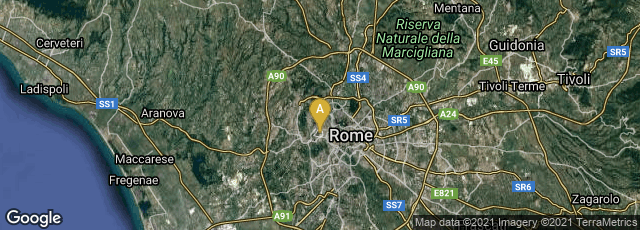

A: Città del Vaticano, Vatican City
Cicero, De re publica, fragment (palimpsest). Biblioteca Apostolica Vaticana, Ms. Vat. Lat. 5757, fol. 277r.
Vat. Lat. 5757, a fourth century palimpsest of Cicero's De re publica (De res publica, De republica) preserved in the Vatican Library, represents the largest part of the surviving text of this work. It was palimpsested in the seventh or eighth century with a commentary of St. Augustine on the psalms. The palimpsest was formerly in the library of Bobbio Abbey.
In 1819-1822 Cardinal and philologist Angelo Mai discovered and published the undertext of the palimpsest. Ironically, Cicero's first century BCE political text had been preserved when the vellum leaves were copied over with a religious text at a time during the Middle Ages when interest in classical texts was minimal, and vellum was very expensive. Before Mai's discovery "Scipio's Dream" was the only larger excerpt of the text that was known to have survived the Middle Ages. Somnium Scipionis survived because it was the subject of a commentary (Commentarii in somnium Scipionis) by the early fifth century Roman writer Macrobius, who excerpted large portions. Both Macrobius and his readers in the Middle Ages and Renaissance were mainly interested in its discussion of astrology and astronomy, especially given the loss of the rest of the text. An enterprising copyist early in the textual tradition appended a copy of the Somnium to a copy of Macrobius's Commentary, but this copy appears to be inferior to the text available to Macrobius, who wrote during the twilight of the Roman Empire before the destruction of most of the Roman libraries. The text that accompanied Macrobius's commentary became so popular that its transmission was "polluted" by multiple copies—so many that it became impossible to establish a stemma for it. The other fragments of De re publica are mainly quotes found in the work of other authors, including Augustine and the Roman grammarian Nonius Marcellus. Through the discussion of Cicero's treatise by these authors the main topics of each book in Cicero's work can be surmised.
Cardinal Mai's discovery was one of "the first major recoveries of an ancient text from a palimpsest, and although Mai's techniques were crude by comparison with later scholars', his discovery of De Republica heralded a new era of rediscovery and inspired him and other scholars of his time to seek more palimpsests" (Wikipedia article on De re publica, accessed 09-14-2010).
In July 2019 a digital facsimile of the complete Vat.lat.5757 was available from the digi.valib.it at this link.